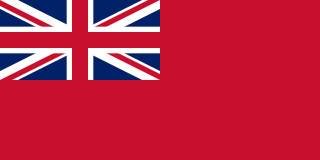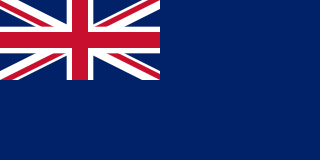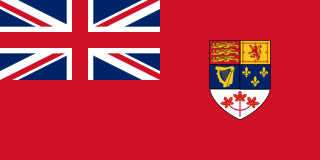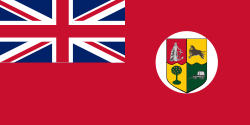
The Union of South Africa was the historical predecessor to the present-day Republic of South Africa. It came into existence on 31 May 1910 with the unification of the Cape, the Natal, the Transvaal, and the Orange River colonies. It included the territories that were formerly a part of the South African Republic and the Orange Free State.

The Union Jack, or Union Flag, is the de facto national flag of the United Kingdom. Though no law has been passed officially making the Union Jack the national flag of the United Kingdom, it has effectively become the national flag through precedent. The flag has official status in Canada, by parliamentary resolution, where it is known as the Royal Union Flag. As they are localities within the British state, or realm, it is the national flag of all of the British overseas territories, although local flags have also been authorised for most, which may be flown in place of, or along with the national flag. Governors of British Overseas Territories have their own flags, which are the Union flag with the distinguishing arms of the colony at the centre. The Union Flag also appears in the canton of the flags of several nations and territories that are former British possessions or dominions, as well as that of Hawaii. The claim that the term Union Jack properly refers only to naval usage has been disputed, following historical investigations by the Flag Institute in 2013.

The flag of South Africa was designed in March 1994 and adopted on 27 April 1994, at the beginning of South Africa's 1994 general election, to replace the flag that had been used since 1928.

An ensign is the national flag flown on a vessel to indicate nationality. The ensign is the largest flag, generally flown at the stern (rear) of the ship while in port. The naval ensign, used on warships, may be different from the civil ensign or the yacht ensign. Large versions of naval ensigns called battle ensigns are used when a warship goes into battle. The ensign differs from the jack, which is flown from a jackstaff at the bow of a vessel.

The Red Ensign or "Red Duster" is the civil ensign of the United Kingdom of Great Britain and Northern Ireland. It is one of the British ensigns, and it is used either plain or defaced with a badge or other emblem, mostly in the right half.

In British maritime law and custom, an ensign is the identifying flag flown to designate a British ship, either military or civilian. Such flags display the United Kingdom Union Flag in the canton, with either a red, white or blue field, dependent on whether the vessel is civilian, naval, or in a special category. These are known as the red, white, and blue ensigns respectively.

The Ossewabrandwag (OB) was an anti-British and pro-German organisation in South Africa during World War II, which opposed South African participation in the war. Pro-German Afrikaners formed the Ossewabrandwag in Bloemfontein on 4 February 1939.

The current flag of the Falkland Islands was adopted on 25 January 1999 and consists of a defaced Blue Ensign, with the Union Flag in the canton and the Falkland Islands coat-of-arms in the fly.

The Blue Ensign is a flag, one of several British ensigns, used by certain organisations or territories associated or formerly associated with the United Kingdom. It is used either plain or defaced with a badge or other emblem.

The flag of the Cayman Islands consists of a Blue Ensign defaced with the British overseas territory's coat of arms. Adopted in 1959 to supplement the Union Jack and to replace the flag of the Colony of Jamaica, it has been the flag of the Cayman Islands since the territory was granted self-government that year. The design of the present flag entailed removing the white disc and outlining the coat of arms with a white trim, although the previous version is often used in an official capacity. The Cayman Islands' flag is similar to the flags of eight other British Overseas Territories, which are also Blue Ensigns with their respective coats of arms.

The White Ensign, at one time called the St George's Ensign due to the simultaneous existence of a cross-less version of the flag, is an ensign worn on British Royal Navy ships and shore establishments. It consists of a red St George's Cross on a white field, identical to the flag of England except with the Union Flag in the upper canton.

The current state flag of New South Wales was officially adopted by the government of New South Wales in 1876.

The Canadian Red Ensign served as a nautical flag and civil ensign for Canada from 1892 to 1965 and later as an unofficial flag of Canada before 1965. The flag is a British red ensign, with the Royal Union Flag in the canton, adorned with the shield of the coat of arms of Canada.

The flag of Cape Colony was the official flag of the Cape Colony from 1876 to 1910. It formed part of a system of colonial flags that was used throughout the British Empire.

The Flag of Transvaal was the official flag of the Transvaal colony in South Africa from circa 1903 to 1910. It formed part of a system of colonial flags that was used throughout the British Empire. It was superseded by the flag of the Union of South Africa.

Since unification in 1910, South Africa has used a range of national symbols to identify the country: coats of arms, official seals, flags, national anthems, and floral, bird, animal, and other emblems.

The Historical flags of the British Empire and the overseas territories refers to the various flags that were used across the various Dominions, Crown Colonies, Protectorates, territories which made up the British Empire and current Overseas territories. Early flags that were used across the Empire tended to variations of the Red and Blue Ensigns of Great Britain with no colonial badges or coat of arms attached to them. In the first half of the 19th Century, the first colonies started to acquire their own colony badges, but it was not until the UK Parliament passed the Colonial Naval Defence Act 1865 that the colonies were required to apply their own emblems.

The flag of South Africa from 1928 to 1994 was originally used by the Union of South Africa from 1928 to 1961 and later the Republic of South Africa until 1994. It was also used in South West Africa until 1990 when the territory was under South African rule. Based on the Dutch Prince's Flag, it contained the flag of the United Kingdom, the flag of the Orange Free State and the flag of the South African Republic in the centre. A nickname for the flag was Oranje, Blanje, Blou.

The coat of arms of South Africa between 1910 and 2000 was granted to the Union of South Africa by King George V and later amended by the British College of Arms. It contained representation of the four provinces within the Union. The coat of arms was later retained by the Republic of South Africa for a period until the end of apartheid in 1994. The 1910 coat of arms was replaced in 2000 by a more Africanised coat of arms of South Africa.



















